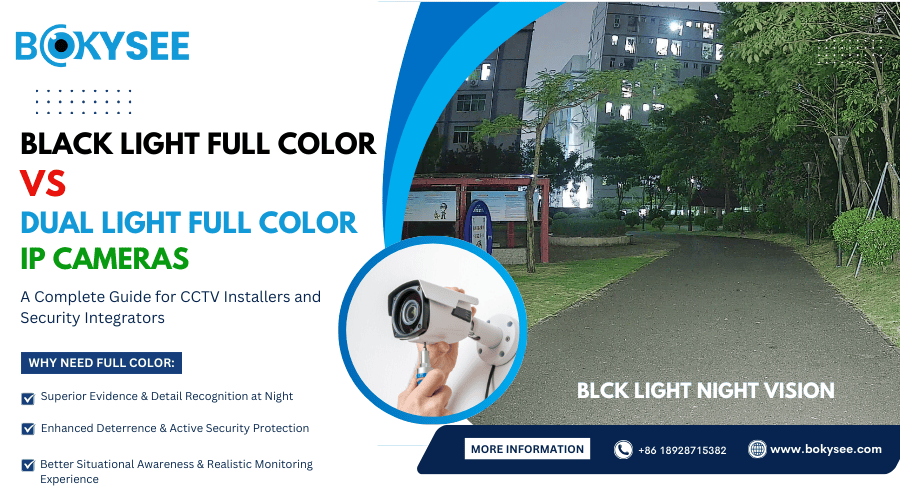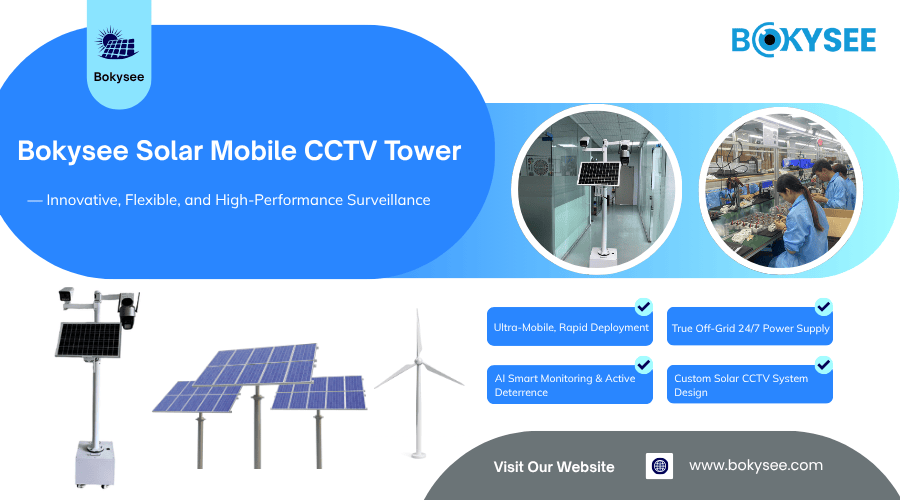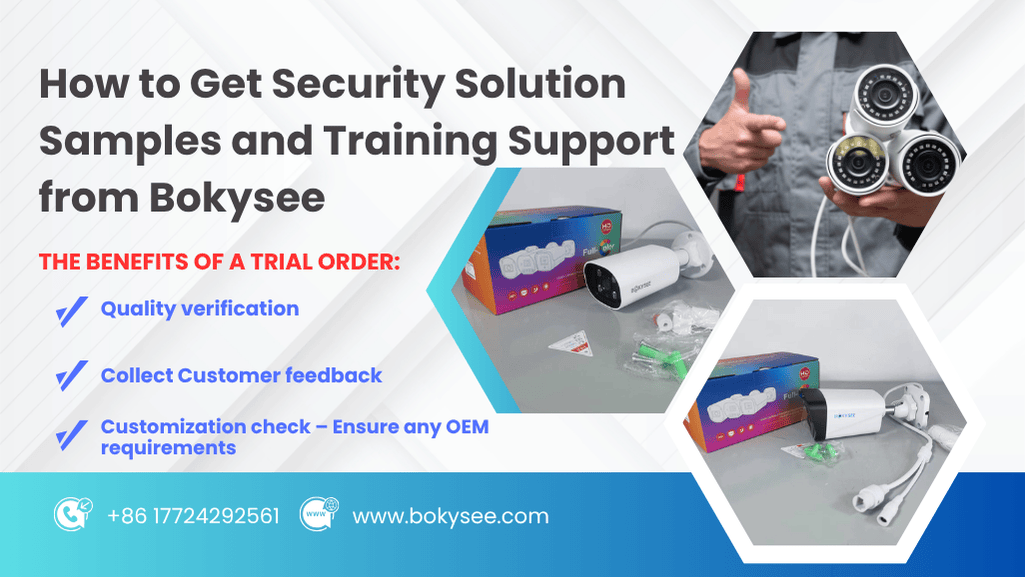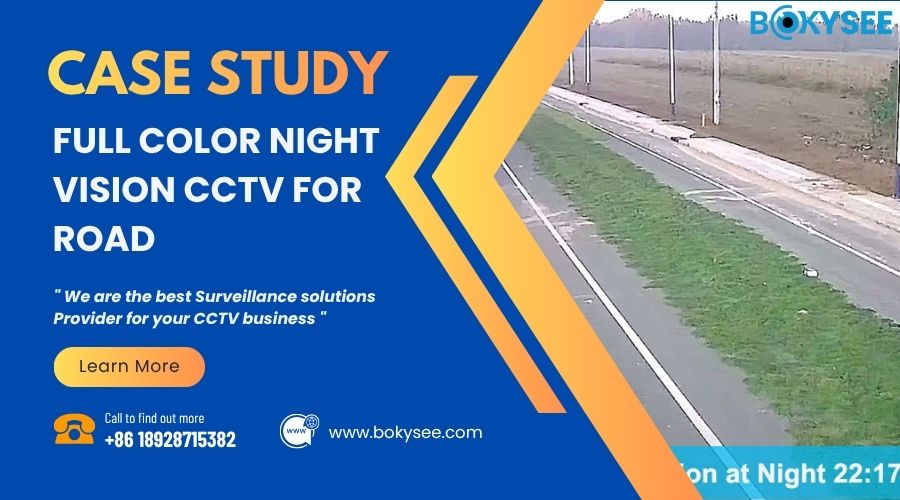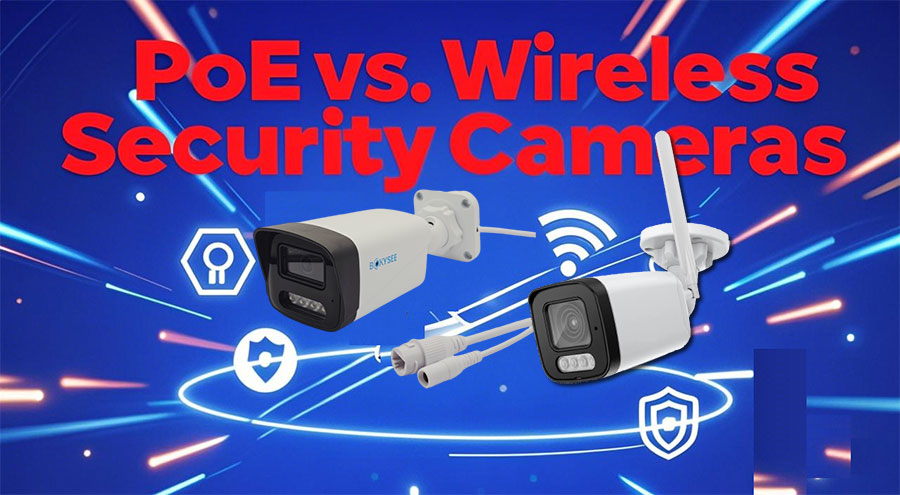
Безопасность очень важна для промышленные места. Фабрикам, строительным площадкам и шахтам нужны мощные камеры, чтобы обеспечить безопасность. Эти места имеют сложные условия и сложную планировку. При рассмотрении PoE против беспроводных камер безопасности, важно выбрать правильную систему для улучшения мониторинга и обеспечения бесперебойной работы. Камеры PoE используют один кабель Ethernet для стабильного подключения, в то время как беспроводные камеры обеспечивают гибкость для настройки в удаленных районах.
PoE против беспроводных камер безопасности
Что такое PoE (питание через Ethernet)?
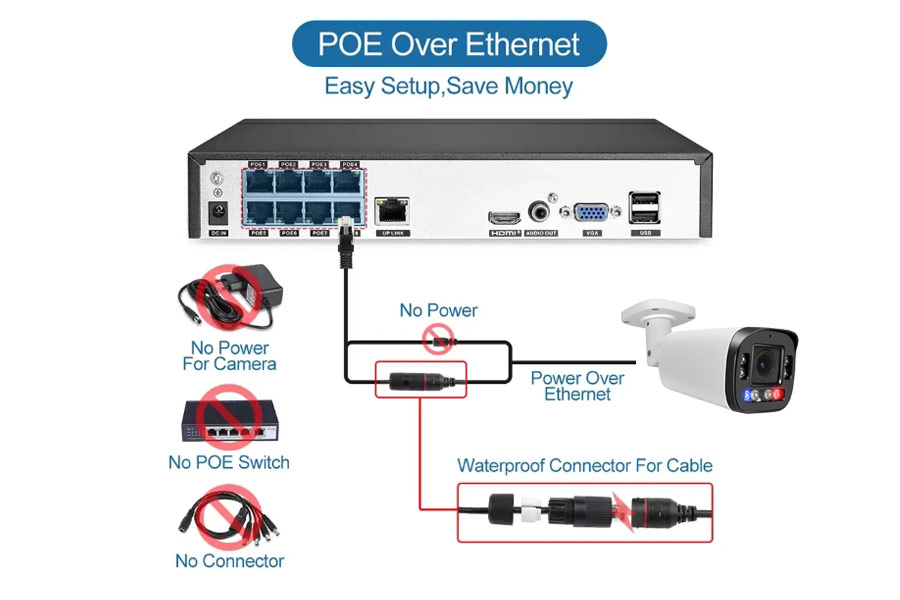
Как работают камеры PoE
PoE использует один Ethernet Кабель для питания и данных. Это устраняет необходимость в дополнительных шнурах питания. PoE камера подключается к коммутатору или инжектору. Кабель передает на камеру как энергию, так и данные. Такая настройка обеспечивает бесперебойную работу камеры. Она также снижает вероятность проблем с подключением.
Промышленные зоны получают большую выгоду от PoE Камеры. Проводное соединение обеспечивает стабильность данных и отсутствие помех. Многие PoE Камеры имеют такие функции, как четкое видео и оповещения о движении. Они делают PoE камеры отлично подходят для наблюдения за большими территориями.
Основные характеристики камер PoE
PoE-камеры имеют много преимуществ для промышленного использования:
- Простая настройка: Один Ethernet кабельные марки простая установка.
- Надежная работа: Проводные соединения позволяют избежать проблем с сигналом и работают стабильно.
- Умные функции: Такие инструменты, как оповещения о движении и HD-видео, улучшают мониторинг.
- Центральный контроль мощности: Силовое оборудование управляет всеми камерами в одном месте.
Промышленные объекты часто выбирают PoE Камеры за их надежность. Передача питания и данных по одному кабелю избавляет от беспорядка и расходов. Это делает PoE камеры — разумный выбор для сложных сцен.
Что такое беспроводные камеры видеонаблюдения?
Как работают беспроводные камеры
Беспроводные камеры используют WiFi для передачи видео. Они подключаются к маршрутизаторам или точкам доступа для передачи данных. Большинство беспроводных камер работают от аккумуляторов или солнечных панелей. Без кабелей их можно разместить практически где угодно.
Беспроводные камеры хорошо работают там, где трудно установить кабели. Но сила сигнала WiFi имеет значение. Стены или устройства могут блокировать сигналы. Батареи или солнечные панели требуют регулярных проверок для поддержания работы камер.
Основные характеристики беспроводных камер
Беспроводные камеры предлагают особые преимущества для определенных нужд:
- Гибкое размещение: Отсутствие кабелей означает, что камеры можно устанавливать в труднодоступных местах.
- Быстрая настройка: Меньшее количество проводов ускоряет установку.
- Легко перемещать: Камеры можно перемещать в любое время.
- Вариант использования солнечной энергии: Солнечные панели продлевают срок службы аккумуляторов на открытом воздухе.
Беспроводные системы хороши для краткосрочного использования или мест с небольшим количеством ресурсов. Но слабые сигналы и ограничения мощности могут вызвать проблемы. Пользователи должны проверить область, прежде чем выбирать беспроводные камеры.
Сравнение PoE и беспроводных камер безопасности
| Особенность | PoE-камеры | Беспроводные камеры |
|---|---|---|
| Источник питания | Питание через один кабель Ethernet (Power over Ethernet) | Питание от аккумуляторов или солнечных панелей. |
| Требования к электропроводке | Один кабель для питания и передачи данных, что избавляет от беспорядка | Не требуются кабели, идеально подходит для мест, где сложно проложить провода |
| Установка | Требуется настройка кабеля Ethernet, лучше всего подходит для профессиональной установки. | Быстрая и простая установка, подходит для самостоятельного монтажа |
| Стабильность сигнала | Проводное соединение обеспечивает стабильную работу без помех | Зависит от сигнала WiFi, на работу могут влиять стены или другие устройства. |
| Умные функции | Поддерживает HD-видео, обнаружение движения и интеллектуальный мониторинг | Также поддерживает HD-видео, обнаружение движения и интеллектуальные оповещения. |
| Централизованное управление питанием | Централизованное управление питанием через коммутатор PoE для всех камер | Обычно управляется индивидуально через сетевое соединение. |
| Рекомендуемое использование | Промышленные зоны, заводы, офисные здания — там, где надежность имеет решающее значение | Строительные площадки, сельские районы, парковки — там, где нужна гибкость |
| Обслуживание | Централизованное питание упрощает текущее обслуживание | Батареи нуждаются в замене или солнечные панели требуют хорошего солнечного света |
| Мобильность | Стационарная установка, не подходит для частого перемещения | Легко перемещать и переустанавливать по мере необходимости |
Установка и настройка
Требования к проводке для камер PoE
Камеры PoE используют один кабель Ethernet для питания и данных. Это устраняет необходимость в дополнительных шнурах питания. Для установки кабели подключают камеры к коммутатору PoE или инжектору. Промышленным объектам нравится такая установка, потому что она уменьшает беспорядочную проводку. Проводное соединение остается прочным даже вблизи тяжелых машин или электроники.
Планирование кабельных трасс важно для настройки камер PoE. Кабели Ethernet могут достигать только около 100 метров. Для больших площадей коммутаторы или удлинители могут помочь с большими расстояниями. Такая организованная проводка делает камеры PoE надежными для долгосрочного использования.
Настройка беспроводных камер
Беспроводные камеры передают видео через сети WiFi. Они подключаются к маршрутизаторам или точкам доступа во время настройки. Большинство из них работают от батарей или солнечных панелей, поэтому шнуры питания не нужны. Это позволяет легко размещать их в труднодоступных местах, например, в удаленных районах или на временных объектах.
Установка беспроводных камер происходит быстрее, чем системы PoE. Пользователи просто размещают камеры и проверяют сигнал WiFi. Стены или устройства могут ослаблять сигналы, поэтому размещение имеет значение. Батареи или солнечные панели требуют регулярных проверок, чтобы камеры работали. Беспроводные камеры отлично подходят для краткосрочного использования или мест с небольшим количеством ресурсов.
Связь и надежность
Стабильность сети системы PoE
Камеры PoE используют проводной Ethernet для стабильного, надежного соединения. Эта настройка из окружающей среды. Промышленные объекты с металлическими конструкциями или машинами имеют меньше проблем с PoE. Стабильное соединение обеспечивает плавное, высококачественное видео.
Проводные камеры PoE также повышают безопасность. Физические соединения затрудняют взлом. Эта надежность делает камеры PoE лучшим выбором для критического наблюдения в промышленности.
Проблемы с сигналом беспроводной системы
Беспроводные камеры зависят от WiFi, который может сталкиваться с помехами. Толстые стены, металлические предметы или другие устройства могут ослабить сигнал. Слабые сигналы могут привести к размытому видео или обрывам соединения. Сложные промышленные макеты часто ухудшают ситуацию.
Сети WiFi делят полосу пропускания с другими устройствами, замедляя скорость в часы пик. Тщательное размещение камер и маршрутизаторов может помочь уменьшить проблемы. Усилители сигнала или ячеистые сети улучшают покрытие в больших пространствах. Тем не менее, беспроводные системы менее надежны, чем проводные, в сложных условиях. Источник питания и резервное копирование
Возможности питания и резервного копирования PoE
Камеры PoE получают питание через кабели Ethernet, минуя электрические розетки. Коммутатор PoE питает все камеры одновременно. Эта центральная установка питания легко управлять и сокращает время простоя. В промышленности это позволяет камерам работать даже при перепадах напряжения.
Резервное питание для PoE включает в себя источники бесперебойного питания (ИБП). ИБП поддерживает работу камер во время отключений, избегая перерывов в наблюдении. Объединение питания и данных в одном кабеле делает камеры PoE надежными для постоянного мониторинга.
Варианты беспроводного питания камеры
Беспроводные камеры используют батареи или солнечные панели для получения энергии. Аккумуляторные батареи обеспечивают гибкое размещение, но требуют частой подзарядки. Солнечные панели продлевают срок службы батарей, особенно на открытом воздухе при солнечном свете. Эти варианты хорошо подходят там, где нет розеток.
Ограничения мощности могут повлиять на беспроводные камеры. Разряженные батареи или слабый солнечный свет могут помешать их работе. Проверка уровня мощности и выполнение технического обслуживания помогают избежать проблем. Беспроводные камеры удобны для временных установок, но не так надежны, как PoE, для долгосрочного использования.
Соображения стоимости
Начальные затраты на системы PoE
Камеры PoE изначально стоят дороже беспроводных. Для них нужны специальные инструменты, такие как коммутаторы PoE или инжекторы, которые увеличивают цену. Покупка кабелей Ethernet и найм установщиков также увеличивают бюджет. Многие промышленные объекты платят экспертам за правильную установку кабелей.
Более высокая цена камер PoE идет с лучшими характеристиками. Они предлагают четкое видео, оповещения о движении и простое управление питанием. Эти преимущества оправдывают первоначальные затраты. Системы PoE служат долго и хорошо работают, что делает их разумным выбором для отраслей.
Текущие расходы на беспроводные системы
Беспроводные камеры дешевле купить, но потом они будут стоить дороже. Батареи нужно заменять, а солнечные панели требуют ухода, что увеличивает расходы. Для лучшего WiFi на больших территориях могут потребоваться усилители сигнала или ячеистые сети, что еще больше повышает расходы.
WiFi на заводах часто имеет проблемы, вызывающие простои или дополнительные исправления. Беспроводные камеры хороши для краткосрочного использования, но системы PoE более надежны с течением времени. Проверка батарей и сигналов часто поддерживает работу беспроводных камер, но увеличивает расходы. Это делает системы PoE более подходящими для долгосрочных нужд.
Плюсы и минусы PoE и беспроводных камер безопасности
Преимущества камер PoE
Надежное и устойчивое соединение
Камеры PoE используют провода для передачи данных без перебоев. Кабели Ethernet устраняют проблемы с сигналом от стен или устройств. Это помогает промышленным объектам получать четкое видео в важные моменты. Надежные соединения означают плавное наблюдение без задержек.
Простое управление питанием в одном месте
Системы PoE используют один кабель Ethernet для питания и данных. Центральный концентратор, как коммутатор PoE, питает все камеры. Такая настройка обеспечивает работу камер при перепадах напряжения. Фабрики могут легко управлять многими камерами из одного места.
Недостатки камер PoE
Сложнее установить
Камеры PoE требуют тщательного планирования для установки. Провода должны соединять камеры с коммутаторами или инжекторами. Крупные промышленные объекты часто нанимают экспертов для планирования путей проводки. Это увеличивает начальные затраты на инструменты и рабочую силу.
Требуется проводная настройка
Камеры PoE зависят от кабелей для работы. Добавление большего количества камер означает добавление большего количества проводов. Изменение планировки на заводах может сделать проводные системы сложными. Кабели ограничивают места размещения камер.
Преимущества беспроводных камер
Простота установки и перемещения
Беспроводным камерам не нужны провода для работы. Их можно быстро разместить без сверления или прокладки кабелей. Удаленные районы или временные площадки легко охватить. Заводы экономят время, используя беспроводные камеры в сложных местах.
Отлично подходит для краткосрочного или удаленного использования.
Беспроводные камеры хорошо работают там, где нет розеток поблизости. Камеры на батарейках не нуждаются в электрическом подключении. Солнечные панели помогают батареям дольше работать на улице. Временные проекты или краткосрочные работы выигрывают от этих портативных камер.
Минусы беспроводных камер
Могут возникнуть проблемы с сигналом
Беспроводные камеры используют WiFi для передачи видео. Толстые стены или металлические предметы могут блокировать сигналы. Слабые сигналы могут привести к размытости видео или отсутствию кадров. Оживленные промышленные зоны с машинами усугубляют эту проблему.
Wi-Fi становится медленнее, когда его используют много устройств. Это снижает качество видео и задерживает данные. Добавление усилителей сигнала или ячеистых сетей помогает, но стоит дороже. Тщательное размещение камер и маршрутизаторов может уменьшить эти проблемы.
Короткое время работы батареи
Беспроводные камеры работают от батареек или солнечных панелей. Батареи нужно часто заряжать или менять, что занимает время. Низкий заряд батарей может остановить камеры и оставить пробелы в безопасности. На крупных промышленных объектах сложно регулярно проверять батареи.
Для хорошей работы солнечным панелям нужен солнечный свет. Облачные дни или тень могут сделать их менее эффективными. Камеры могут перестать работать без достаточного питания. Регулярные проверки поддерживают работу камер, но добавляют дополнительную работу. Камеры с питанием от аккумуляторов хороши для краткосрочного использования, но не для долгосрочных нужд.
Выбор правильной системы камер видеонаблюдения для промышленных объектов
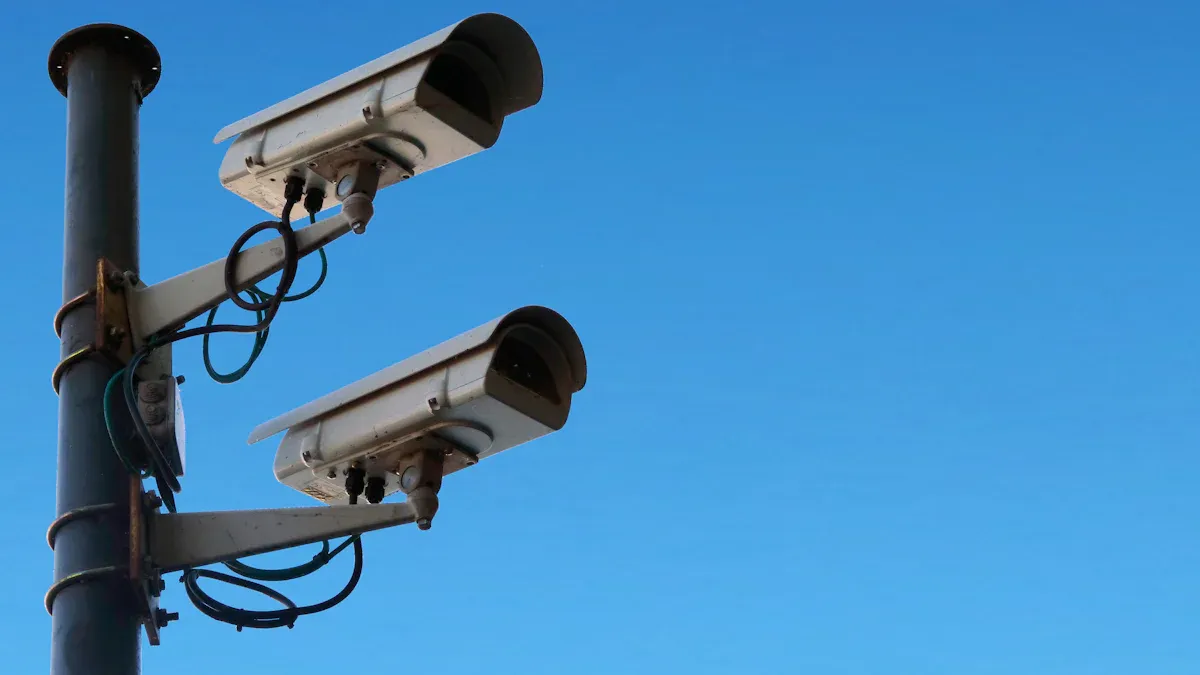
Факторы, которые следует учитывать
Размер и планировка объекта
Размер и форма объекта влияют на выбор камеры. Крупным объектам нужны камеры, которые охватывают большие площади. PoE-камеры Здесь они работают хорошо, потому что используют стабильные кабели. Кабели Ethernet могут передавать данные на расстояние до 100 метров без проблем. Беспроводные камеры могут испытывать трудности в больших пространствах из-за слабых сигналов.
Небольшие помещения или временные установки лучше подходят для беспроводных камер. Отсутствие кабелей означает, что их можно легко перемещать куда угодно. Беспроводные системы отлично подходят для изменения макетов или краткосрочных проектов. Проверка размера и дизайна объекта помогает выбрать лучшую систему камер.
Условия окружающей среды
Окружающая среда имеет значение при выборе системы камер. Для сложных условий, таких как жара, пыль или дождь, нужны прочные камеры. PoE-камеры созданы для решения этих задач. Их проводная установка позволяет им работать вблизи машин или помех.
Беспроводные камеры лучше всего работают в спокойной обстановке. Для хорошей работы им нужен стабильный WiFi и немного препятствий. Плохая погода или заблокированные сигналы могут вызвать проблемы. Знание обстановки помогает найти систему камер, которая работает надежно.
Рекомендуемые продукты
PoE-камеры Bokysee
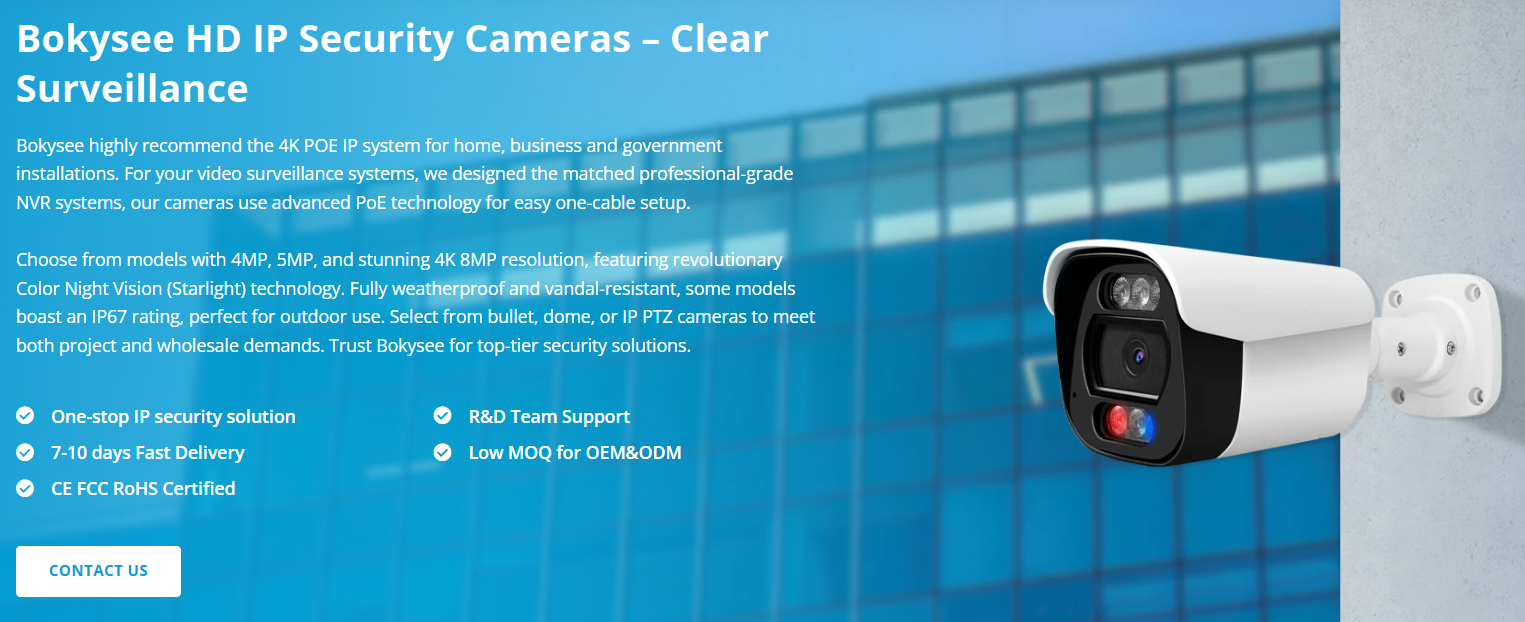
Бокизее PoE-камеры отлично подходят для промышленной безопасности. Они обеспечивают четкое видео и обладают интеллектуальными функциями, такими как оповещения о движении. Один кабель Ethernet упрощает настройку и уменьшает беспорядок. Эти камеры стабильны и хорошо работают в сложных условиях.
С коммутатором PoE вы можете управлять несколькими камерами одновременно. Это экономит время и сохраняет порядок. Камеры Bokysee PoE прочные и долговечные, что делает их идеальными для сложных промышленных работ.
Беспроводные камеры Bokysee
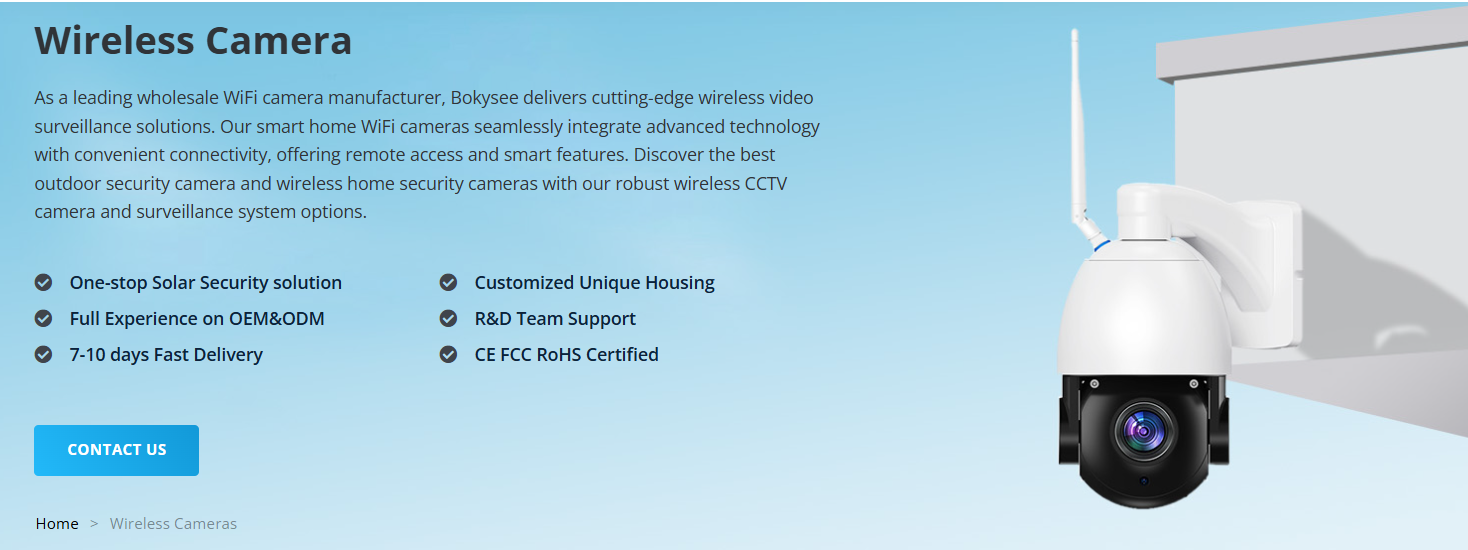
Беспроводные камеры Bokysee подходят для гибких потребностей в безопасности. Их легко устанавливать и перемещать. Варианты с питанием от аккумуляторов не нуждаются в розетках, а солнечные батареи помогают им дольше работать на улице.
Эти камеры обеспечивают четкое видео и просты в использовании. Усилители сигнала могут улучшить их дальность на больших площадях. Беспроводные камеры Bokysee лучше всего работают там, где сильный WiFi и мало помех. Они отлично подходят для временных или меняющихся установок.
Реальные приложения
Практические примеры установки камер PoE
На фабрике использовались камеры PoE для наблюдения за производственными линиями и складами. Им требовались стабильные соединения для четкого видео. Система PoE поддерживала работу камер во время перепадов напряжения. Камеры хорошо справлялись с тяжелыми условиями фабрики.
На другом объекте камеры PoE использовались для охраны большой территории. Длинные кабели покрывали всю территорию без потери сигнала. Проводная установка избегала помех от близлежащих машин. Эти камеры улучшили безопасность и упростили управление.
Практические примеры установки беспроводных камер
На строительной площадке беспроводные камеры использовались для отслеживания прогресса и безопасности. Отсутствие кабелей означало быструю установку в отдаленных местах. Аккумуляторы и солнечные панели обеспечивали им более долгую работу. Камеры легко подстраивались под меняющуюся планировку площадки.
Место проведения мероприятия использовало беспроводные камеры для краткосрочной безопасности. Они охватывали точки входа и толпы без необходимости в проводах. Усилители сигнала помогали сохранять четкость видео. Эти камеры хорошо справлялись с временными потребностями мероприятия.
Часто задаваемые вопросы о камерах безопасности PoE и беспроводных камерах безопасности
Распространенные вопросы
Могут ли камеры PoE работать без интернета?
Да, камеры PoE могут работать без интернета. Кабель Ethernet обеспечивает питание и передает данные локально. Сетевой видеорегистратор (NVR) сохраняет видео для последующего просмотра. Интернет нужен только для удаленного доступа или облачного хранения.
На какое расстояние могут передавать сигналы беспроводные камеры?
Беспроводные камеры могут передавать сигналы на расстояние до 300 футов на открытой местности. Стены, металл или устройства могут значительно сократить это расстояние. Усилители сигнала или сетчатые системы помогают покрывать большие пространства. Регулярные проверки поддерживают сильный сигнал в сложных местах.
Советы по устранению неполадок
Устранение проблем с подключением PoE
Проблемы с PoE часто возникают из-за плохих кабелей или низкого уровня мощности. Проверьте кабели на наличие повреждений, чтобы они работали хорошо. Используйте коммутатор PoE с достаточной мощностью, чтобы избежать дефицита. Проверьте сеть с другим устройством, чтобы найти проблемы.
Усиление мощности беспроводного сигнала
Слабые беспроводные сигналы возникают из-за помех или неудачного размещения. Переместите камеру ближе к маршрутизатору для улучшения сигнала. Используйте менее загруженные каналы WiFi, чтобы избежать помех от устройств. Добавьте усилители сигнала или сетчатые системы для больших площадей.
PoE-камеры обеспечивают стабильное соединение, простое управление питанием и высокую производительность. Беспроводные камеры гибкие, быстро настраиваются и отлично подходят для краткосрочного использования. У обеих систем есть свои плюсы и минусы. Подумайте о размерах объекта, окружающей среде и будущих потребностях, чтобы выбрать лучшую.
Bokysee имеет первоклассный PoE-камеры для тяжелых промышленных работ и беспроводные камеры для гибких настроек. Проверьте эти варианты, чтобы соответствовать вашим потребностям. Выбор правильной системы повышает безопасность, упрощает мониторинг и обеспечивает бесперебойную работу.
Смотрите также
Повысьте безопасность вашего дома с помощью камер видеонаблюдения POE
Понимание систем камер PoE и их преимуществ
Лучшие наружные камеры видеонаблюдения PoE в 2025 году
Ведущие камеры видеонаблюдения 4K PoE, которые стоит рассмотреть в 2025 году
Лучшие беспроводные PTZ-камеры для улучшенной наружной безопасности

